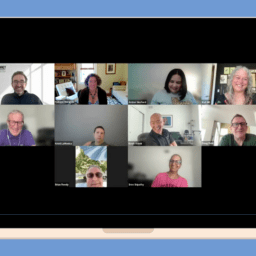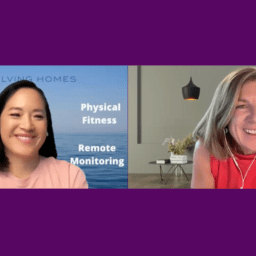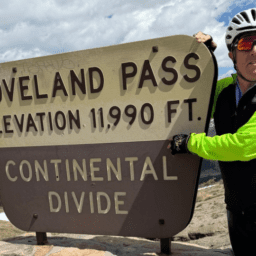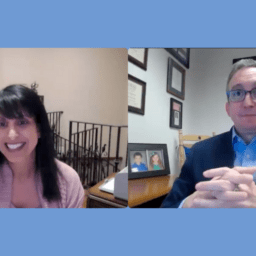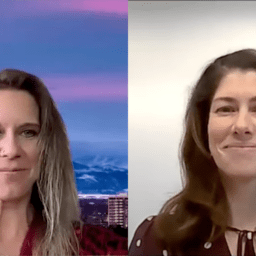episode summarY
In this episode, panelists Yasar Torres-Yaghi (movement disorder specialist), Amanda Craig (occupational therapist), and Joe Van Koeverden (person with Parkinson’s), discuss how to manage motor symptoms during OFF times in Parkinson’s. In particular they discuss:
- What is an OFF time?
- Distinguishing OFF times from other “feelings”
- The impact of stress on OFF times
- How to adapt your home for OFF times
- Optimizing your medications
- Non-motor symptoms associated with OFF times
- Rescue meds/rescue therapy
- Rational polypharmacy
- On demand and as needed medications
- Planning your schedule around OFF times
- Having a realistic expectations of tasks
- Taking brain breaks
- Can exercise reduce ON times?
- Do endorphins have anything to do with OFF times?
listen now
Read below for the transcript, or download here.
Jackie Hanson (Education Program Manager – Audio and Video Producer):
Hello everyone and welcome to the Parkinson’s Podcast. This podcast is brought to you by the Davis Phinney Foundation and brings you experts from around the country as well as additional educational and inspirational resources to help you live well today with Parkinson’s.
Hello everyone. Welcome and we are so glad you’re here. My name is Jackie Hanson and I’m the Education Program Manager of Video and Audio Production here at the Foundation and I am very glad you’ve found us today. If this is your first time listening to the podcast, welcome. Please feel free to reach out to us at any time to get in touch. You can reach us at blog@dpf.org. We always look forward to hearing from our new listeners, new community members and we also love directing people to our free resources and anything that we can offer to help you live well today with Parkinson’s.
For today’s episode we are featuring a conversation that we hosted as a part of Victory Summit Virtual Event all about motor symptoms. In this conversation three panelists, Dr. Yasar- Torres-Yaghi, a movement disorder specialist, Amanda Craig, an occupational therapist, and Joe Van Koeverden, a Davis Phinney Foundation Ambassador and person with Parkinson’s, discuss how to deal with motor symptoms during OFF times. In particular, they discuss the following:
- What is an OFF time?
- How do you distinguish OFF times from other “feelings” as Joe will further describe?
- How do you adapt your surroundings to make OFF times easier?
- How do you optimize your medications to reduce OFF times?
- What are the available options for medications including rescue meds or rescue therapy, on demand meds and as needed medications?
- How do you plan your schedule around OFF times and maintain realistic expectations of yourself?
- What are the non-motor symptoms that can occur during OFF times in addition to the motor ones?
They will discuss these questions and much much more.
Polly Dawkins, the executive director of the Davis Phinney Foundation is the moderator for this discussion, so with that, let’s go ahead and get this conversation started.
Polly Dawkins (Executive Director, Davis Phinney Foundation):
Hello everyone. And welcome.
Yasar Torres-Yaghi, MD (Physician, Medstar Georgetown University Hospital):
Hi.
Amanda Craig, OTR/L, CBIS (Occupational Therapist and Owner, Ada Therapy Services, PLLC):
Hi.
Polly Dawkins:
I am glad that the three of you have raised your hand to say yes, you would join us to talk about managing motor symptoms from your different perspectives during OFF times. I’ll do a really quick intro, ask you how you would like me to refer to you during this, and then we’ll get started. So, Dr. Yasar Torres-Yaghi, that’s a big mouthful. How would you like me to refer to you in this session today?
Yasar Torres-Yaghi:
My mother gave me eight names, so the there’s like five more, but no, you can call me anything, Yasar, Torres-Yaghi or Dr. Yaghi or Yasar, whichever you prefer.
Polly Dawkins:
Okay. Thank you. Thank you for that. And you’re a fellowship trained movement disorder specialist with a subspecialty in neurorestoration research in movement disorders and dementia. What is neurorestoration research?
Yasar Torres-Yaghi:
Wonderful. So, it’s 34 years including preschool to finally make it. And once you’re there, so I did a special kind of very research focused two year fellowship beyond neurology, so movement disorders and neurodegenerative fellowship, where we did clinical research, utilizing therapeutics to help disease modify or slow progression of disease and the therapeutics that do that help us restore neuronal function so that we don’t lose neuronal function. That’s called neurorestoration.
Polly Dawkins:
Thank you for that. That’s helpful. And our friend, Joe Van Koeverden, if I’ve pronounced that correctly.
Joe Koeverden (Ambassador, Davis Phinney Foundation):
Yeah. And just call me, Joe.
Polly Dawkins:
All right. I’ll call you Joe. And you were diagnosed with Parkinson’s in March of 2012. So, 10 years you’ve been living with Parkinson’s and he’s incredibly active in Canada helping spread the message that it is possible to live well with Parkinson’s and thank you for being here today and Amanda Craig. Amanda, great to see you again. Amanda has joined us before. She’s an occupational therapist, a licensed occupational therapist and a brain injury specialist. And you work in the growing town of Boise, Idaho.
Amanda Craig:
Uh-huh. Yeah, I do.
Polly Dawkins:
So many people are moving to Boise.
Amanda Craig:
Yeah. It’s yeah. It’s pretty crazy. Yeah. We’re fortunate enough to have been here for long enough that we have a place to live. Yeah. And thank you so much for having me today.
Polly Dawkins:
Yeah. Well, we’ve asked the three of you to join us, to talk a bit about strategies to manage OFF. And so, I’m gonna go with Dr. Yaghi because I like that way to refer to you and it’s easy and I might not mispronounce it. Can you start the session off with helping us understand what is OFF and are there different types of OFF?
Yasar Torres-Yaghi:
You got it. I think the first step in, in, in terms of making something better is identifying the problem, right? So, it’s always solution driven investigations within our practice. So, we sit down with a patient, we may spend half an hour, sometimes an hour just to put on our investigator hat and kind of figure out exactly what’s going wrong and it’s not easy. You see from the polling question, you know, the responses vary. Interestingly, a quarter of the patients in the polls do feel a negatively impactful effect from their OFF time on a daily basis. So that speaks volumes as to how important it is to have this discussion. Detecting OFF is not as easy as it sounds. Right. So first of all, the concept itself is a little hard to understand, right? So, you may say OFF, what is OFF, you know, is OFF ON or is ON OFF, does OFF mean your Parkinson’s is OFF or does that OFF mean your medicines is OFF?
So, number one, get on the same page as your patient. Number one, right. Is OFF meaning your Parkinson’s is OFF or is OFF the medications is OFF. That’s very important. Another way of thinking about it to peel back that conceptual layer is saying a return of symptoms. So, when in between your carbidopa levodopa regimen that we take multiple times a day, sometimes 3, 4, 5, 6, 7, 8 times a day, possibly, depending on where we are in the disease process, in between those doses, do you feel a return of symptoms due to the wearing OFF of medicines? Now, could it happen in the morning before you take your next dose? You betcha, that’s called OFF, morning OFF, or morning akinesia. What if a patient says, I take my carbidopa levodopa and I feel worse for about an hour, and you say, what? The medicine’s supposed to make you feel better?
And they say, nope, I feel worse. And you say, okay, well, and your investigator hat comes on. You’re no longer a doctor. You’re an investigator. You’re no longer an occupational therapist. You’re no longer a wonderful representative of the Davis Phinney Foundation that understands OFF, so you put on your investigator hat and you say, wait, hold on a second. Are you having a side effect from the medicine? Is your blood pressure dropping when you take your medicine? Like, are you experiencing orthostatic hypotension? Is that what you mean? Or is it that you’re having a delay to ON which is possible. Because remember after you swallow a pill, there’s still time where the previous dose is coming down. So, you may not get to the bottom of that valley even after taking your medicine, you take your medicine, it could take another 60 minutes to come back up.
So, a delay in ON is also an OFF episode. Okay? So, then there’s the end of dose wearing off. Then there’s unpredictable wearing OFF. There’s something called misdose effect. I take my medicine and it never kicked in to begin with and then wearing OFF can happen even at night. So, remember OFF is a major problem in our world. So sometimes we may feel like we don’t actually experience OFF, but the symptoms you have in the middle of the night at 3:00 AM, when it’s hard to move in bed and turn, or you might feel a little cramping that could be an OFF episode. So, detecting OFF is so, so, so important.
Polly Dawkins:
Wow. Joe, do you experience OFF and how do you experience OFF?
Joe Koeverden:
Oh, for sure. And I think he hit it a few times there and I normally experience OFF when I’m not following my schedule for meals and sleep and all those things, it’s usually my own fault. Because sometimes I just wanna squeeze in that lunch, even though I’m within an hour of taking my medication. But the one thing I really liked is the explanation. It was very clear. I like to make sure I’m looking at the OFF, and not any other odd feelings I may have. I have two other odd feelings I talk about which one is feeling down, you know, apathy is a bad thing with Parkinson’s. So, when we just may be feeling down, we don’t want to start treating feeling down with our Parkinson’s medication. The other thing is if we, if we’re feeling done and when you’re feeling done it’s that you’re just tired. Right? I know yesterday we went to Toronto to do a few things and came back at the end of the day and I was done. In fact, I was still done this morning. So, you know, you wanna make sure you are like, the doctor said that you’re treating an OFF time and not any of the other feelings cause the extra medication won’t help the other two.
Polly Dawkins:
Yeah. Do you have a plan for action or a strategy that you use for being OFF or for minimizing it altogether?
Joe Koeverden:
Well, I think the morning time OFF is the hardest one to deal with. So, I like to go down to the basement and do some speed bag punching, do a little boxing, first thing in the morning that gets your body going and any levodopa around will find this way to your brain.
Polly Dawkins:
Got it. And Amanda, what is your recommendation or your experience working with people with Parkinson’s who have OFF times and strategies that you use or recommend for those individuals?
Amanda Craig:
Well, something that Joe touched on is that feeling of being down, that apathy, maybe decreased motivation, maybe there’s other things going on. So, you know, one of the big impacts of OFF times that we see with clients too, is that maybe they’re OFF, you know, having those motor symptoms and their medications not ramped up yet. But the impact of stress is something that’s really what we notice. I mean, just even in our sessions when people are even just thinking about a stressful event or they’re currently experiencing an acute stressful event in their life, we see an increase in those involuntary movements. We see an increase in tremors, language challenges, thinking problems. So, one ideal strategy for people with Parkinson’s is to develop a strong foundation of stress reduction, or stress coping skills. Like Joe mentioned, you know, whether or not he might use boxing to help boost up his movement and his just engagement, it also might, you know, that stimulus, but it also might really reduce some stress.
He might be using that as a stress reduction tool. And so, you could also use something, what we call brain breaks in the therapy world, which is you go to a low stimulation environment. It can be, usually we recommend every two hours for 10 to 15 minutes and someone could cycle this with their medication. And you’re just kind of maybe listening to something light you know, feeling calm, thinking about things. You don’t have to completely reduce all stimulation, because sometimes that increases people’s stress when they’re alone with their thoughts, but you could also do a brain break proactively. So, before you engage in a task, go to an appointment, you can have a brain break in the car. We can’t remove stress completely. It’s part of the human experience. It helps us grow and adapt, but we can change how we perceive it and what we do with that information. And allowing ourselves to experience it even during those OFF times.
Around the house, I know you guys really like to hear around the house stuff for home modifications and to keep in mind that any goal with any home changes is to increase your participation in activities and continue with your independence as much as possible. So, any changes that you might do to your home or work environment or anywhere is to increase participation that includes during your OFF times. So that’s things like good lighting in all areas that you perform tasks or your walkways, you wanna have lighting that reduces glare. Because sometimes when people are in those OFF times, their brain actually isn’t processing lighting and their visual information at the same level.
We notice an increase in falls, you know, from movement things, but also how they’re processing information cognitively. So lighting is really key in that you’re not creating a dark room and a light room in your house. You’re trying to stabilize your lighting throughout the home, as you walk through your home and is especially important during those OFF times in order to reduce falls. You also can organize your work area. So, if you’re having an OFF time, but you’re going to get something out of the bathroom or your kitchen or your desk area. And it’s an organized area where you know where everything is. You’re not knocking things over with your hands. If you’re, you know, having some involuntary movements because your space is organized, that really helps during OFF. Handrails of course, grab bars in all areas. And everyone knows about them in the bathroom, but also having grab bars in places that you might be during your OFF times, that’s the doorway, in and out of your garage, or your house entry or in your closet.
So, think about other places that you are moving and functioning and where you could put some of those home modifications and seating in places around the house, the garage, the yard, super helpful, putting a bench by your front door or whatever entryway you go in and out of your house. So, if you need to sit down and dig for your keys or put your package down and you’re feeling OFF that gives you a safe space to do that in order to get into your house safely, without falls. So trying any of those things to have in your house and set you up for success during your OFF time. So, you don’t have to completely stop moving, but you have some more safety precautions in place.
Polly Dawkins:
Yeah. That those are really great strategies. I’ve also heard that like decluttering, moving impediments to movement and also decluttering so that your brain isn’t so full of all the visual stimuli. Is that something that you experience?
Amanda Craig:
Yeah, definitely. And you think about just decluttering what you see as you walk through a pathway in your house, and that makes such a difference.
Polly Dawkins:
Great. Dr. Yaghi does everyone with Parkinson’s experience OFF symptoms or OFF times, and is it dependent on the medications they take or their disease progression? Can you frame that for us?
Yasar Torres-Yaghi:
Wonderful question. It’s hard over time because Parkinson’s disease early on one might experience strong benefit from their regimen of carbidopa levodopa. So, any formulation of carbidopa levodopa, or any medication that could be even an extended-release formulation of dopamine agonist or a monoamine oxidase inhibitor may in fact provide kind of that dopaminergic tone. We call it the dopaminergic tone and imagine kind of a line. When you wake up, you take your medicines and you’re supposed to stay like this. Your dopamine levels should be constant, should be always at a level to help you move so that you don’t have a return of symptoms. Unfortunately, as the condition progresses, we lose neurons. After the age of 25, we start losing neurons. We no longer make more neurons. We just plateau and then steadily decline and in Parkinson’s disease, we lose the neurons that store and release dopamine.
So that concept’s called the dopamine storage buffering capacity. So, we lose the buffering capacity because we have less neurons. So, we take our medicine and we take them throughout the day. And at one point let’s say year two or three, after disease onset, three doses of carbidopa levodopa, keep our dopamine tone just great. Throughout the day, the night, we never feel our symptoms necessarily return in between our doses. As the condition progresses, we lose that buffering capacity, and our gut becomes less reliable in absorbing the medicines that we swallow. So, we can’t really absorb what we take even when we take it on time. So, our patients are doing their best at taking their medicine on the hour, actually on the minute, you know, to take their medicine on time, that pill burden is so high. And despite being on medicine, they still have wearing OFF.
And the wearing OFF happens in between the doses. So, we may have patients that get one or two hours of benefit from their dose of carbidopa levodopa. And sometimes they’re OFF for two to three hours until their next dose. And so that becomes more and more pronounced that wearing OFF becomes more and more pronounced as the disease progresses. That’s one important piece to this. Another important piece is that it’s not the medicine that makes the wearing OFF worse. The medicine, in fact, unfortunately over time, it’s been shown in multiple studies that even though you have OFF time, you can increase your dose of carbidopa levodopa and despite adjusting up the dose or adjusting up the frequency of carbidopa levodopa, despite those two changes, which those two changes are the logical next steps, if you have more OFF time, despite those two changes OFF continues to exist.
And so once OFF is there, it’s very important, as you mentioned Polly, to address it in different ways, you know, do you have a strategy to take care of these OFF episodes or these OFF times? The first step is understanding that they’re there. As we said earlier, you know, understanding what they are is really the key. Joe said it, you know, first make sure you’ve distinguished the OFF episodes as true OFF episodes, understand when they happen, how long they’re there, how severe they feel, how intolerable they are, that’s the first step and understand when they occur in comparison to when your medicine is given and take it. That’s the key or when you eat a high protein meal, that’s another important factor as protein will reduce absorption of levodopa. Another important piece to understanding OFF is recognizing that first OFF, it’s not always the same. OFF can happen in different ways.
It comes in many shapes and forms. Sometimes it’s a tremor. Sometimes it’s freezing of gait, sometimes it’s falls and to kind of synergize with what Amanda was talking about, sometimes it’s a panic attack. Anxiety can be a symptom of wearing OFF. Slowing cognition, cognitive change, reduced cognitive capacity, not a motor symptom at all, and I know this is mainly a motor conversation in OFF, but that can also be, cognitive change can also be a symptom of wearing OFF. Pain, with or without stiffness and rigidity can be a symptom of wearing OFF. And so all of these things need to be determined when they are, how they happen, and they need to be communicated to the healthcare team in a proper way. That’s why conversations like this. We need more and more of them so that we can equip ourselves as patients to be able to then go and say, hey, doctor and healthcare team, look what’s happening to me. Amanda’s an occupational therapist. When someone comes in to see her, if the patient’s in an OFF episode, we’re in trouble, we’re in trouble because we want exercise. We want occupational therapy. We want physical therapy, speech therapy. We want wellness. We want stress reduction. But if we’re having impactful OFF throughout the day, just that can be intolerable. That roller coaster ride that we talk so much about.
Polly Dawkins:
Yeah. So, in the last handful of years, there have been many different medication alternatives that have come out to deal with OFF or rescue. So, the first question I have again for Dr. Yaghi, is there a difference between medications for and rescue meds?
Yasar Torres-Yaghi:
Great question. So, and the therapeutic landscape has continued to evolve and that’s the beauty of Parkinson’s disease care in 2022 is that it’s a very therapeutically, vibrant field, meaning there are a lot of solutions. If we can figure out the different problems, hopefully for many, there are solutions to those problems and the way you take care of it is one, with what’s called rational polypharmacy. Many drugs from different classes in an irrational way is not a good idea, many drugs in combination, that make sense together that synergize with each other is called rational polypharmacy. That is a good idea. Rational polypharmacy in fact is how we succeed in 2022 in treating patients to keep their dopaminergic tone steady. So, you utilize the different drugs that we have. And to answer your question, yes, there’s a difference between on demand, as needed, or rescue therapies. That is different, that category of drug is different than the maintenance drugs that we utilize for OFF.
So, you can combine carbidopa levodopa with a mono oxidase inhibitor that will help reduce OFF time. That’s a maintenance strategy. You’re just taking a medicine once a day to help reduce the OFF time in between your carbidopa levodopa. You may add a dopamine agonist. Typically, we strive for extended-release formulations, very different than the insurance companies. They want you to utilize immediate release formulations. We like extended-release formulations because you take a pill once a day to keep you like this, that’s much better than taking a pill three times a day that makes you go like this, right? If we could have a once-a-day carbidopa levodopa, we’d be in good shape. Right? But so, what we’re trying to do is utilize medications in unison together, there’s istradefylline
which is an A2A receptor antagonist, which is a maintenance medicine. There is an amantadine, many amantadine derivatives, which can be helpful to reduce levodopa induced dyskinesia and improve OFF time. There’s different formulations of carbidopa levodopa extended-release formulations that hopefully aim to reduce OFF time and improve that good ON time. So, we use all these medicines in combination. However, however, if you look at the as needed therapies, it’s like an asthmatic, like my mom, I brought her up twice today. Maybe she’ll be happy that I bring her up all time.
Polly Dawkins:
You wanna say hi?
Yasar Torres-Yaghi:
Hey mom! No. Yeah, I should have her come. So, the truth is she was an asthmatic growing up. I was growing up and part of the reason I went into medicine was because my mom’s struggle with asthma. She had maintenance drugs that she would utilize, but despite being on maintenance medicines to prevent asthma crises or asthma attacks, she still would have sometimes asthma attacks. She would use her as needed therapies in between if she were to have a crisis and that’s, we need to equip ourselves with not only combination therapy for maintenance drugs, extended-release capacity for all of our drugs, whenever possible for maintenance therapies, but also we need to equip ourselves with the different therapies for OFF in an as needed way. So inhaled levodopa, sublingual apomorphine, injectable apomorphine, even a rescue carbidopa levodopa can be helpful. Fractionating levodopa now is another way of taking a quarter, half tab, three quarter tabs. There are these fractionated pills now that can be helpful in an as needed way.
Polly Dawkins:
That was really helpful. Thank you. Joe, have you ever tried any of these strategies personally, or used any as needed or medications?
Joe Van Koeverden:
Yeah, no, I haven’t used any of those other ones. I use amantadine and I forget how pronounce the other one, the drugs that were previously mentioned is support for my levodopa. But I’m not taking anything specifically for the OFF times. I figure when I have the OFF times I get out and do something, try to get my body moving and just try to work through it, push through it, I guess, is the way to do it.
Polly Dawkins:
Push through it.
Joe Koeverden:
Push through it. Yeah. You talked about morning times. I take a CR in the evening to get me through the night and I wake up at five every morning, so my morning starts early, but I don’t take my levodopa until seven. So, I’m about ready to take my dog for a good walk about 7:15. Am I getting out there with my good walking poles and good shoes on, I get a good walk in with my dog and my levodopa is in place.
Polly Dawkins:
That’s great. Amanda, what are some of the other ways that occupational therapy can help someone with Parkinson’s who is suffering from motor symptoms? And their meds are not working.
Amanda Craig:
Well. So occupational therapists or OTs are masters of organization, scheduling, and routine management. So, an OT can help somebody with Parkinson’s look at their schedule and visually lay out all the things that need to happen, all the activities that need to happen. And we like to break down tasks and the nitty gritty. That’s taking a shower and getting dressed and making your breakfast and all the things that you have to do or want to do during the day. That includes your exercise routine, going to appointments, walking your dog, whatever it is, visiting with family. Those are actually, all those tasks I just listed are what we call occupations in occupational therapy. So, laying those out with, you know, with your occupational therapist and looking at your routine and how you’re utilizing your time, and then trying to visualize and map out where your medication times might work into that.
So, using that piece to create a schedule for you and, you know, so an important aspect of this is knowing also when you should or should not be driving if you’re experiencing OFF times. Nobody wants to be in that stuck position, they’re freezing or experiencing involuntary movements while driving, which obviously is scary and dangerous. And so, sometimes when someone knows that they’re having OFF times and they’re still working on tweaking their medications with their providers, they may need to request rides to appointments that might be part of their routine and part of their schedule, or just knowing that they’re not gonna schedule appointments during that time, you know, to make the most out of their PT or OT or speech therapies. A balanced routine is like a dance that you can sustain. You know, something it’s not too much, not too little, trying to reduce pressure on yourself to do it all when you’re ON, because then that can make your OFF times even more pronounced because you’re exhausted.
We have a lot of people with those highs and lows of endurance and just sort of pacing and they’ll do everything they’re ON and then crash when they’re OFF and trying to find a more balanced world. And of course, you know, as we all know nothing set in stone, as soon as you get your schedule in place and you’re feeling good with your medications and your routine, then something changes, your body changes something in life changes, and that’s okay. You know, we just tweak it. We go back to the drawing board and make a few little adjustments and tweak it throughout, you know, life, it’s not gonna be set forever. And that’s okay. So just utilizing your occupational therapist to help you with that is a great place to start.
Polly Dawkins:
Sounds like everybody needs an occupational therapist on their Parkinson’s team, right?
Amanda Craig:
Yeah. I believe so. Yes.
Polly Dawkins:
Sounds like these strategies are things that we don’t necessarily know on our own.
Amanda Craig:
Yeah. Just the functional, real-life things are really what we focus on, you know and as both what Dr. Yaghi and Joe had mentioned, it’s individual for everybody. So, you know, if you’re talking to your providers, your care team and letting them know what OFF times look like for you, because if you just say I’m having OFF times, that, to me, I don’t really know what that means. So, I usually ask a lot of questions. Like, are you, you know, is it this? Is it this? Describe to me, or sometimes if I’m doing a home visit with somebody, I’ll see them during their OFF times, and I can really see, oh, now I know what you’re talking about and then I can make recommendations accordingly.
Polly Dawkins:
Got it, Dr. Yaghi there’s a question that I think you could answer best in the chat. Can repetitive activities like game apps and Sudoku and puzzles, deplete dopamine, and therefore bring on fatigue or OFF times?
Yasar Torres-Yaghi:
A question we get asked a lot, either with kind of cognitive processing. I’m the director of the Parkinson’s and dementia clinic at Georgetown as well. So, I handle a lot of cases where I try and maintain cognitive capacity, you know? And so that’s why that’s a very, very important question. Certainly, it’s important to try your best to maintain kind of intellectual exercising. You know, you want to keep that as part of your life, you know, socialization, reading, brain training exercises. It’s not uncommon for us to prescribe cognition therapy for our patients through either occupational therapy or speech therapy to help us go through brain training exercises for our patients. But yes, either physical drainage and cognitive drainage can occur. If you’re utilizing your brain capacity for either movement or thinking, yes, you can deplete your energy.
You know, if you go through a period of time where you’re trying to focus and maintain attention, you’re utilizing your brain for Sudoku or things like that. You got it. You can have cognitive fatigue, you can lose some of that cognitive endurance because yes, you use those chemicals. You can use those chemicals up, your dopamine levels, acetylcholine levels, all those neurotransmitters are there, but the more you utilize them, then the more, you’re exhausting them, you’re depleting them. So yes, you can run out. You can get exhausted pretty easily. Right? But that said, it’s like if you were to do bicep curls, right? Or what Joe was mentioning, doing exercise, working through his OFF episodes, you know, you wanna keep those muscles strong. Your brain is a muscle. So, one day you may get exhausted at one hour of Sudoku, right? And then you say, oh my goodness, I need a break. You know, let me get some water. Let me take a little break, maybe a mental break. Amanda was calling it a, I think…
Amanda Craig:
A brain break.
Yasar Torres-Yaghi:
A brain break. I love it. I’ve never heard that before. And I love it. Because you may need a brain break after doing something that’s exhaustive like that. That said, if you keep exercising your brain with more and more Sudoku, you can improve your endurance too. And so, remember the brain is a muscle. You have what’s called neuroplasticity. You can reinforce the circuits that are functional by exercising your brain and you can augment the electrical pathways throughout the brain by more and more exercise. Just like if you were to exercise by doing a big and loud program or you’re doing just walking, every time you walk, hopefully the goal is you can, you can walk farther the next time that you do your walk. And so that’s exactly what you’re doing and you may need less brain breaks the more exercise you do.
Polly Dawkins:
That would be beneficial, wouldn’t it? Joe, I know you’re a huge fan of exercise. Tell us a little bit about what your routine is and how do you exercise through OFF times? I know you said you went and boxed in the morning when you wake up.
Joe Koeverden:
Yeah. Walking is, has always been… oops.
Polly Dawkins:
You’re good.
Joe Koeverden:
Good. Walking has always been my go-to exercise over the years. I worked through cancer about 20 years ago and after the surgery and all that, I used to walk all the time, you know, hours a day. And it’s a couple years ago I walked a million steps during the summer to raise awareness for Parkinson’s.
Polly Dawkins:
Wow.
Joe Koeverden:
That’s a million steps on trails, not a million steps around my house. But it was just a way of getting out there. And I found that not only the exercise, but using the proper equipment, I eliminated all the injuries I used to have cause I was working so effectively with the equipment. But yeah, so, and then also just by myself, an E trike, an electric assist trike that has two big wheels to gimme lots of stability. I’m not a little guy, so I needed something that can handle me and I can feel comfortable in that’s not gonna break when I sit on it. And so, it’s given me a whole different angle cause it’s really fun. And in order to keep being active, I gotta take a time when one of the activities has to be a lot of fun by doing that…
Polly Dawkins:
Such a good point.
Joe Koeverden:
It keeps you going.
Polly Dawkins:
Is your E trike an upright or recumbent?
Joe Koeverden:
Recumbent?
Polly Dawkins:
What fun.
Joe Koeverden:
So, like on Sundays I go to the flea market, which is about 10 or 15 kilometers away. And then back again, I recharge it at the flea market to make sure I got enough assist to get me all the way home, but it’s a good run.
Polly Dawkins:
That’s great. Dr. Yaghi, there’s a question in the chat about does exercise, I’m sorry, does exercise tend to shorten ON times?
Yasar Torres-Yaghi:
Yeah. So, exercise can help us cope with OFF times. It depends on the person. You have some people that when they are expending their energy and they’re exercising more, they do feel almost like they drain themselves from the dopamine levels that they have. Right. Cause it’s almost like you’re doing more. So, you’re using more dopamine to help you move. So, I do hear that at least anecdotally in the clinic, I’m not sure it’s ever been studied, actually looking at dopamine levels in your body. It’s hard to correlate that with actual functionality. There’s no true biomarker of dopamine, either in the blood or the cerebral spinal fluid that we can monitor during activities like that. So, it’s all based on report. And so, if a patient sometimes says, you know, I do these exercises, but then I feel like my Parkinson’s symptoms return after an hour of exercise, I feel like I’ve depleted my dopamine stores.
You say, well, you know, that can happen. And I think what’s really happening is that we are living with lower levels of dopamine when we are struggling with Parkinson’s. And so, it’s even more important to optimize your therapies, utilize the maintenance drugs so that you are maintaining dopaminergic tone, the better your dopaminergic tone, the better you’re going to be at coping even subtle decreases of dopamine in your body, right? So that’s where these as needed therapies can be helpful if you hit a very low, low point a Nader, but also what’s helpful is maintenance drugs, utilizing combination therapy, utilizing extended-release formulations so that you have this almost like basal foundational amount. Imagine you utilize one medicine that gets your dopamine tone here.
It’s once a day. Now you’ve added another once-a-day medicine here, you’re utilizing your carbidopa levodopa. But these two medicines that you’ve added to your regimen don’t allow for, when you wear OFF of your levodopa, they stop you from going too far down. They stop you right here. Because now you’ve had two layers of extended-release formulations, so you can’t drop down deep into the valley and that’s where those maintenance drugs really do help. So that reducing the severity of those OFF times so that you can exercise. So, you can go to your occupational therapy appointments, so that you can do all of the different exercises that Joe does to keep his body functional and everything. So, it really is a multi-pronged approach. You’re utilizing all these strategies, but therapeutics is a very important piece to that puzzle.
Polly Dawkins:
Yeah, for sure. Somebody asks and I know we’re getting short on time. We could talk forever about this topic with you all. But does the interaction of endorphins from exercise have any interaction with dopamine or anything to do with OFF or ON? Tell us about that. Whoever has experience with endorphins or…
Yasar Torres-Yaghi:
Well, I’ll be brief just so someone else can answer, but you got it, every time you exercise several things happen. The first thing is we talked about the concept of neuroplasticity, right? You’re reinforcing those circuits that aren’t affected by Parkinson’s. There’s multiple circuits that help you move and you can make them stronger by exercise and you can maintain the basal ganglia circuitry that’s affected in Parkinson’s. You can strengthen that too, even though it’s affected, neuroplasticity. Second concept is what you mentioned, wonderful question, endorphins. Those are chemicals that are released when you exercise, they make you feel good. They help reduce rigidity and stiffness. They make you feel better mental health wise, they make you feel more energy. So, endorphins and all of those chemicals, those chemokines are pain relieving, they make you feel happy, they make you more alert. So that’s great for not just your mobility, but your cognitive function and your mental health. Okay. The third piece, when you exercise, you’re actually improving the levels of the chemicals that help prevent neuronal loss. So, it’s been shown that brain derived neural growth factor, a chemical needed to keep the strength of the myelin sheaths in the brain, as you exercise, you’re actually increasing the levels of brain derived neuro growth factor. So, exercise, exercise, exercise.
Polly Dawkins:
Yes.
Amanda Craig:
I agree. Yeah. And people often think that with Parkinson’s you can’t make improvements or improve your endurance or improve your cognition. And that’s just, it’s not true. We see it all the time and it’s really, really motivating for people to see that progress and continue with it.
Joe Koeverden:
Yeah.
Polly Dawkins:
It’s a, go ahead, Joe.
Joe Koeverden:
I noticed something the other day I was cutting the backyard, cutting the grass in the backyard. And I noticed that I finished the whole backyard without a break. And four years ago, I used to have to take a break halfway through the backyard, but now it’s four years later, expect me have a lower energy and now I can do all the grass cutting, including the little front yard I got all in one swipe. That’s just…
Polly Dawkins:
It’s a victory.
Joe Koeverden:
A victory.
Polly Dawkins:
Yay. Thank you all so much for being here and I’m sorry, we don’t have more time together because what we’re learning is just so important to overall wellbeing with Parkinson’s. Well, thank you to the three of you so much. We appreciate your expertise and work that you all are doing in the Parkinson’s community.
Amanda Craig:
Yeah. Thanks for having us.
Polly Dawkins:
Take care.
Jackie Hanson:
Thank you so much for listening to today’s episode. If you enjoy this podcast, please consider subscribing, leaving a review or giving us four stars. Your comments and ratings help us to expand our reach and provide our free resources to even more people in the Parkinson’s community.
A big thank you to Joe, Yasar, and Amada for their time and contribution to this conversation. We’re so grateful to all of the people in the Parkinson’s community that help to provide valuable information and insight to help all people with Parkinson’s to live well.
Last but not least, please remember that this is just one of the many free offerings from the Davis Phinney Foundation. Not only do we have countless additional resources to help you live well with Parkinson’s through our blog, YouTube channel, events, and more, but we also have ambassadors all around the country ready to help YOU. These are people with Parkinson’s, care partners for people with Parkinson’s, and medical professionals, ready to help guide you through the complexities of this diagnosis. Thanks everyone so much for being here, and we will see you next week.
For the video recording of this episode, click here.
more from the davis Phinney foundation
Related Resources
- A Haiku Practice for Mindfulness
- Parkinson’s and Apathy: A Primer
- Stress Management, Mindfulness, and Parkinson’s
- Setting Up Your Home Environment to Live Well with Parkinson’s: A Blog Series
- Occupational Therapy and Living Well with Parkinson’s with Amanda Craig
- OFF: What it is and How to Manage it with Dr. Yasar Torres-Yaghi
- The Davis Phinney Foundation’s Home Safety Checklist
Additional Offerings from the Davis Phinney Foundation
- The Every Victory Counts® Manual: a free comprehensive resource on Parkinson’s and how to live well with it
- Live Webinar Events and Series
- The Victory Summit® Virtual Events
Listen & Subscribe
Apple Podcasts | Stitcher | SPOTIFY
If you enjoy this podcast, please help us out by leaving a comment, giving us 4 stars, and subscribing! We love hearing from our community and your comments and reviews will help us improve the show and reach even more people with Parkinson’s.
contact us
Contact us anytime at blog@dpf.org



